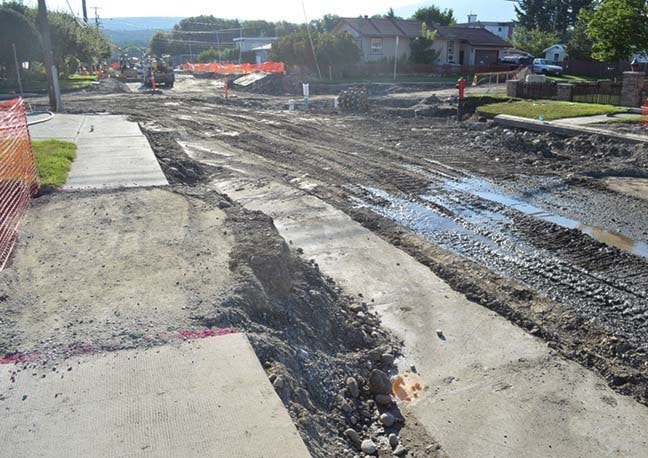Having been raised on the legends and myths of the Trojan War, I find great romance in the adventures of archeologists. Imagine that fellow Heinrich Schliemann, who more than 150 years ago proved that legend was history when he excavated the site of Troy. It has since been determined that nine cities are located there, piled on top of each other. From thriving metropolis to ghost town, over and over again for countless centuries. Fantastic stuff!
So I'm ready to believe — when an ancient sidewalk is unearthed in the city of Cranbrook — that buried below our city of the present is an historical city of Cranbrook, and below that, perhaps a legendary city of Cranbrook, and below that ...
I went down to see the ancient sidewalk, buried four feet beneath Sixth Street North for who knows how many decades, this week seeing the light of day again thanks to the road construction efforts underway.
"Look at that ancient sidewalk," I said to myself, in proper tones of awe. "Imagine the feet that sidewalk has had on it. Perhaps the legendary schoolmarm Amy Woodland rode her bicycle down this sidewalk. Perhaps Valentine Hyde Baker challenged someone to a fight right here. Maybe crowds had gathered on this very sidewalk to watch a parade go by, a parade filled with skittish elephants.
"This sidewalk is living, breathing history," I said to myself again, more excitedly. "Workmen!" I shouted. "Stop your labours! There are artifacts of paleo-historiographical significance entombed in the hereabouts that must be exhumed without delay for the erudification of us all!" The workmen ignored me, and I walked away brooding.
I inquired of the local historians the mysteries behind the ancient sidewalk, and I was quickly disabused of my romantic notions. But if this exposed stretch of concrete was no legendary sidewalk, it was, in fact, an even more fabled artifact, a legendary piece of infrastructure that no one was even sure had actually existed.
What the workmen had exposed was the Smith Creek culvert.
The Smith Creek Storm Sewer was cast by the City of Cranbrook in the Skating Rink in the late 1920s and early 1930s, and laid out in 1935. It consisted of — consists of — 5,320 feet of concrete pipe, 30 inches in diameter, with a grade of 0.284 per cent, according to the Cranbrook Courier.
The Courier report (1944) adds:
"The third artificial interference with the natural drainage was a small dam constructed on Smith Creek where it passes under Wattsville Road, 3,750 upstream from the intake of the storm sewer. At this point, the creek issues from a large swamp several miles in length. The purpose of the dam was to flood the swamp, thus forming a shallow lake intended to serve as a bird sanctuary. The dam raised the level of water in the swamp four feet ..."
So there it is in a nutshell — the creation of Elizabeth Lake and the drainage system under downtown Cranbrook to Joseph Creek. Flooding at Elizabeth Lake this year, and attendant concerns over its drainage, led many to think about that mysterious infrastructure which had been buried for so long no one was really sure where it was.
But there it is. And my sources say the City engineer says the culvert is in very good condition and running about 12 inches deep through that 30-inch pipe.
So in many ways, this is better news than the discovery of the legendary Cranbrook — that a key piece of infrastructure is alive and well after all those decades.
But still, as I walk along our excellent modern sidewalks, my eyes drift downward and I ask myself, "what else is down there?"
Thanks to David Humphrey
